Banning Quilts
The story of how my quilt about the loss of women's reproductive rights was censored by a major quilt exhibitor for subject matter
Banning quilts is not just ridiculous, it’s insidious. It’s easy to think it doesn’t matter much in a world with so much going wrong, but when a male-run organization—that makes its money from their mostly female members—steps in to decide what’s appropriate for these members to see at quilt shows, it’s an attempt to silence all of our voices, not just the banned artist’s. Quilts are traditionally a woman’s art form and as such have always been an outlet for our hopes, dreams, and yes, protests even back in the days when we had less say about our lives than we do now.
Censoring art is one of the surest signs that a culture is under attack, which is why I believe it’s vital that we keep talking publicly about what’s happening on every level. It’s especially important to document actions that appear to be small and petty, like censoring quilts for subject matter, because it always escalates from there unless we say ‘no’ loud and clear.
This post is mostly for the Substackers who found me through this site. It’s the story of a quilt that I made which was banned by a major quilt exhibitor due to its subject matter—women’s reproductive rights. It’s also the story of the online quilting community that took swift action and sent an unequivocal message that this was unacceptable. I wanted to write it down as a record for myself as well as for those who might not know about it. If you followed along on Instagram or Facebook last winter, this account provides more detail.
While this newsletter is primarily about my quilting process and life—hopefully providing a small respite from the chaos we’re surrounded by—I felt this story was important enough to share more fully.
It’s the reason I’m here, writing on Substack. I will always be a strong voice for women’s rights.
The Instagram Post
It all began on January 29, 2025, when I got an email that my quilt—Your Mother. Your Daughter. Your Sister. Your Grandmother. You.—which is part of the multiyear traveling exhibition Color in Context: Red, run by Studio Art Quilter’s Association (SAQA)—had been banned by a host venue, American Quilter’s Society (AQS) from all of their five shows in 2025 because of its subject matter.
Not accepting this decision quietly, I wrote a post about it on Instagram that went viral within the quilting world, resulting in the entire exhibition of thirty-nine quilts being pulled from all AQS venues.
The Quilt
As stated in my artist’s statement (you can read it here as well as at the bottom of this post), I made this quilt in the spring of 2022 when the overturning of Roe v. Wade was leaked. Horrified that women would lose access to a safe medical procedure that saves lives, I started working out my frustration and anger the only way I know how: by making art.
The quilt’s construction is simple: a classic red-and-white quilt using an improv sixteen-patch block construction. The colors are arranged to form a dissolving red cross, which I saw as a potent symbol for the dissolving of women’s reproductive rights across our country.
I worked on the piecing throughout the spring and then used the long arm at my local quilt shop to do the quilting. I had it bound and ready to submit to QuiltCon in the fall of 2022.
Meanwhile, I began work on the artist statement. Getting the tone right was crucial; I wanted my quilt and words to communicate to the broadest possible audience. I wanted women from all corners of this country to find something that resonated within themselves. All women know someone who’s experienced the unexpected with their reproductive health, from infertility to miscarriage to traumatic labor and delivery to abortion and stillbirth. These events are politically agnostic. I personally know women who’ve lived through every one of these situations. Even the title of the quilt is meant to express this truth. Whether the women in your life have told you about these experiences or have held them unspoken, I guarantee you that they’ve all experienced something.
After months of work (with invaluable help from my husband, a professional editor), I felt like I got it just right—sincere and straightforward, without provocation or ideology. I knew it might offend some people, but I was happy to send it out into the world, confident that a majority of women would find a piece of their own truth within it.
QuiltCon and SAQA’s Color in Context: Red
The first show I entered it into was QuiltCon 2023. It was my first time entering a quilt show, and I was elated when it was accepted. It hung in Raleigh, NC, in February 2023 and was warmly received. I got notes from people who told me that it brought them to tears.
While it was still with QuiltCon, I entered it into the SAQA call for the global Color in Context: Red traveling exhibition. These SAQA traveling shows run for three years, so I knew that if it got in, the quilt would be widely seen. I can hardly express how I felt when it was accepted by the juror Judy Kirpich to be part of what is a truly world-class showcase of stunning textile art.
I got the quilt back from QuiltCon, turned it right around and sent it off to SAQA. All in all, this quilt had been in my hands for less than a year.
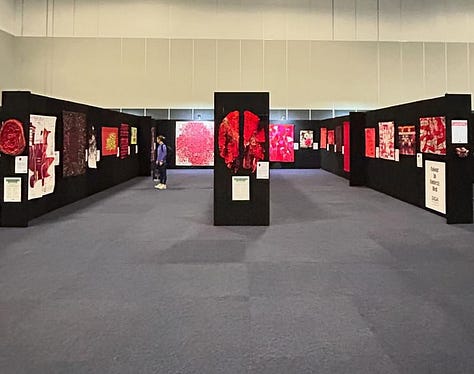
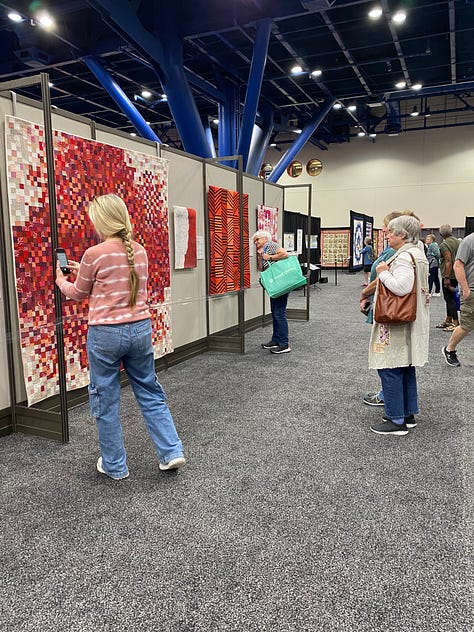
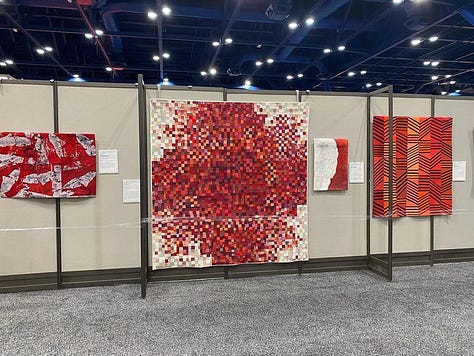
Traveling
The first stop of the SAQA show was the Houston Quilt Festival in October 2023. I flew down to see it and the rest of the show, which is breathtaking—I urge you to go see it if it comes anywhere near you. No one had any issues with either the quilt or the artist statement in Houston. There are other quilts in the show that deal with difficult themes—violence against Indigenous women, wildfires, COVID. Red is a potent color in many cultures, and this show reflects that truth.
The show then traveled throughout Australia for the entirety of 2024. No issues reported, only positive feedback.
In August of 2024, SAQA and AQS signed a contract for the show to be hung at all five of their venues in 2025 (Daytona Beach, FL, Paducah, KY, Grand Rapids, MI, Branson, MO, and Lancaster, PA). The date is significant. It was before the election, and no one knew where the country was headed. AQS, who had the show catalog in hand, had the opportunity to see every artwork and read every artist statement.
AQS has a long-standing relationship with SAQA, as they host their global exhibitions every year. AQS is also known to be conservative, and they’ve censored artwork in the past (see below). When I got the notification that they would be hosting the show for the entire year, I admit I was concerned about how my piece would be received. AQS is not a quilt show I would ever submit to; it’s just not the right fit for me. So it’s important to know that I did not submit my quilt to them to be shown; it was accepted as part of a traveling show.
I believe to this day that the vast majority of people in attendance at AQS would have had no problem with this quilt or its artist statement.
Banning the Quilts
Then, at the end of January, the email arrived. Due to “venue constraints,” it read, my piece would not be shown and would be held in storage until 2026.
I have to acknowledge that SAQA’s email left much to be desired. It was perfunctory, failed to offer a real explanation, and was silent about potential remedies. One could only conclude that for SAQA, this was a done deal. (But I do want to state clearly that SAQA very quickly stepped up and did the right thing, and I remain a stalwart supporter of the organization).
I felt sick to my stomach and was in a shock that this had actually happened. I immediately emailed back and asked if it was because of subject matter and if there were any other quilts that were not being allowed to hang. They answered that unfortunately, it was due to subject matter, but they didn’t answer me about any other pieces being removed from the show. After consulting with my private quilt group, I decided to post about it on Instagram. This was a Friday morning.
It very quickly blew up. By the end of the day, I found out that there was indeed another piece banned—Origin, by Yvonne Iten-Scott—because AQS decided it looked like “lady parts” (spoiler alert: it’s not about that at all). Yvonne and I quickly connected, and together we navigated what came next.
The good and feisty quilters of Instagram and Facebook wasted no time
They contacted SAQA and AQS and demanded that either the entire show be shown as-is or pulled. At first, I felt equivocal about this, because I knew it would be a huge disappointment for the other artists in the show. But once I learned that it was not just my quilt, I changed my mind and agreed. The show must be seen as the juror intended. If AQS had a problem with it, they should have said so before they signed the contract back in August. But here we were, days after the inauguration of a new administration that is overtly hostile to women’s rights, and I believe the men who run this show felt fully empowered to cherry pick per their political views.
All the attention spurred SAQA into action. Over the weekend, they attempted further negotiations with AQS, but by Sunday, SAQA decided to pull the whole show. It was a unanimous decision by the board. They immediately issued a statement, the result of which is that they gained hundreds of new members and goodwill. More importantly, they stood by their commitment to support their artist members.
AQS has not responded, as far as I know, to anyone about this situation. But I do know from all the letters and notes I’ve received that they’ve lost many members. One of the main reasons I went public is so that people, women mostly, who spend good money to be part of this “society”—it’s member-funded—and pay to enter and attend their shows know who they are giving their money to. If you agree with them, then that’s great. But if you don’t, then it’s good to know who they are.
I also want to state that I defend AQS’s right to host whatever kind of show they want. This isn’t about that. They needed to either agree to take the entire traveling exhibition or to refuse it in its entirety. The juror’s vision must be respected and not second-guessed.
And oh yeah, they’ve done it before
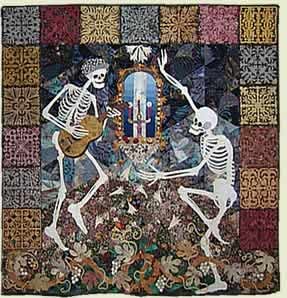
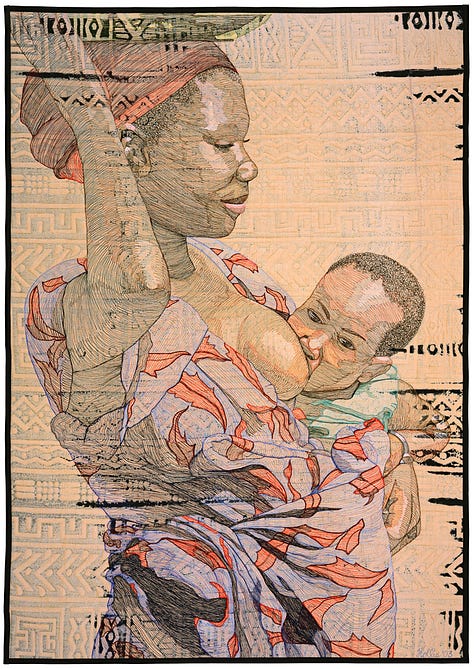

AQS has a history of censorship. You know the old saw: when someone tells you who they are, believe them.
In 1994, AQS banned a quilt, Amigos Muertos, by the award-winning Jonathan Shannon because it honored friends lost to the AIDS epidemic. There’s nothing graphic about his quilt. It’s another instance of subject matter being not to their tastes. His quilt went on to win at England’s Patchwork Championship, and it has been honored as one of the one hundred most important quilts of the century.
In 2009, AQS banned the gorgeous quilt by Hollis Chatelain Burkinabe Woman, because it depicts a mother nursing her infant. What could be more life affirming and beautiful than this image?
In 2016, AQS pulled Kathy Nida’s quilt I Was Not Wearing a Lifejacket from the Grand Rapids show after someone complained about male body parts being in her work. Despite there being exactly zero penises, they pulled her quilt anyway. Her quilt was also part of a traveling SAQA exhibit. See below for a link to her blog post about it.
The Fallout
By the end of that hectic weekend and my failed attempt to keep up with the flood of comments on Instagram (there are 14,383 likes, 1,817 shares, 842 saves, and 825 comments—I’ve read them all—with new ones still showing up), my quilt had been acquired by the International Quilt Museum in Lincoln, Nebraska, and Yvonne’s piece had been purchased by an anonymous collector.
Of all of the comments and private messages I received, there were very few that were not fully supportive. Even the women who told me that they didn’t agree with my views on abortion access stated very clearly that the quilt should have been shown. This was not a case of “women policing women,” which was something that came up in the comments a lot. AQS is run by two men.
Within a very short time, the Mancuso-run shows Mid-Atlantic Quilt Festival, and Pennsylvania National Quilt Extravaganza, plus the A Quilter’s Destination shows, each stepped up to host the exhibition in 2025. I’m deeply grateful to them because the rest of this show deserves to be seen, not just Yvonne’s and my quilts.
While these shows are smaller than the AQS venues, they often overlap, nowhere more jarringly than Paducah Quilt Week, which was in April of this year. AQS is the Big Daddy of what used to be a vibrant and diverse citywide quilt festival, with many smaller quilt shows participating. The A Quilter’s Destination show has been a part of it for years, and they were there again this year, hosting the entire SAQA Color in Context: Red show. Many people showed up at the smaller venue specifically to see the banned quilts. Sadly, they lost their venue going forward and will no longer be part of Paducah Quilt Week.
Media
Because of the current state of extreme censorship in our country, this situation also got a fair amount of media attention. There was something so ridiculous about quilts being banned. Quilts! How harmless. It was a perfect moment to talk about art censorship in general and also the secret world of quilter’s who’ve always expressed themselves and their feelings through their work.
There are links below to a roundtable discussion about art censorship that Yvonne and I participated in hosted by Rue Pigalle, an arts group in Canada, plus articles in various art magazines, blog posts, and a podcast.
As of this writing, June 2025, the quilt is still being shown and has another year to go before it goes to the International Quilt Museum as part of its permanent collection. I’m fairly certain it will be part of a gallery exhibition in New York City this October along with other censored art—not just textiles, but paintings, photographs, and sculpture. I’ll keep posting updates about its travels in the regular newsletter and then add to this post to keep it an up-to-date record.
Some ground rules for the comments below: keep it civil. Chances are you will disagree with some of the things I write, or that other commenters write. That’s OK. What’s not OK is to berate me or someone else. The topic here is censorship, not abortion. If you are pro-censorship, then that’s on you. Please remember: you do not have to read this or be a subscriber to my posts. I have a strict policy to block anyone who comments just to start a battle, because it’s pointless. You do you and I’ll do me.
Links
(** links specifically about this quilt)
Kathy Nida, You Won’t Find a Penis at AQS Grand Rapids . . .
Jonathan Shannon, PBS American Quilts
** Hyperallergic Art News, “Is Female Anatomy Too “Controversial” for the American Quilter’s Society?”
** IO Alien, Why I’m Boycotting the American Quilter’s Society
** Textile Art Insider, “Laura Shaw Responds to AQS Censorship of Her Art Quilt”
** Rue Pigalle Toronto, Panel discussion, “Censorship is Never OK”
** Rev Craft Biz Podcast with Sam Hunter, episode 045, “Your Mother. Your Daughter. Your Sister. Your Grandmother. You. - with Laura Shaw”
** Instagram posts, Laura Shaw Quilts
Full Artist Statement
Started in the spring of 2022, after the leak of the draft Supreme Court decision to overturn Roe v. Wade, I felt the need to work through my anger and frustration knowing that this fundamental human right to essential health care was soon to be lost for millions of women.
When seen from a distance, the more than 3,000 squares of this quilt form a red cross that swirls and fractures around the edges, eroding just as reproductive rights are eroding across America. Viewed up close, each square, made up of red fabrics that cover the full spectrum from purple to orange, solid to patterned, is uniquely shaped, a visual reminder of how each woman must uniquely cope with the unpredictability of having a uterus—from miscarriage to infertility, failed birth control to traumatic birth and delivery—and how all women collectively depend on and benefit from access to safe, legal reproductive care and safe, legal abortion.
As I cut and stitched up each block, I thought about how this disastrous decision, rendered by five men and one woman, will impact us all—women most directly, our families by extension.
The red cross is an internationally recognized symbol of protection and care offered to all in times of conflict and disaster. I can think of no better symbol to represent this unfolding calamity for American women, for those they love, and for those who love them.

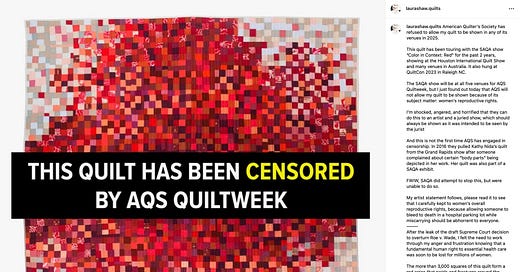



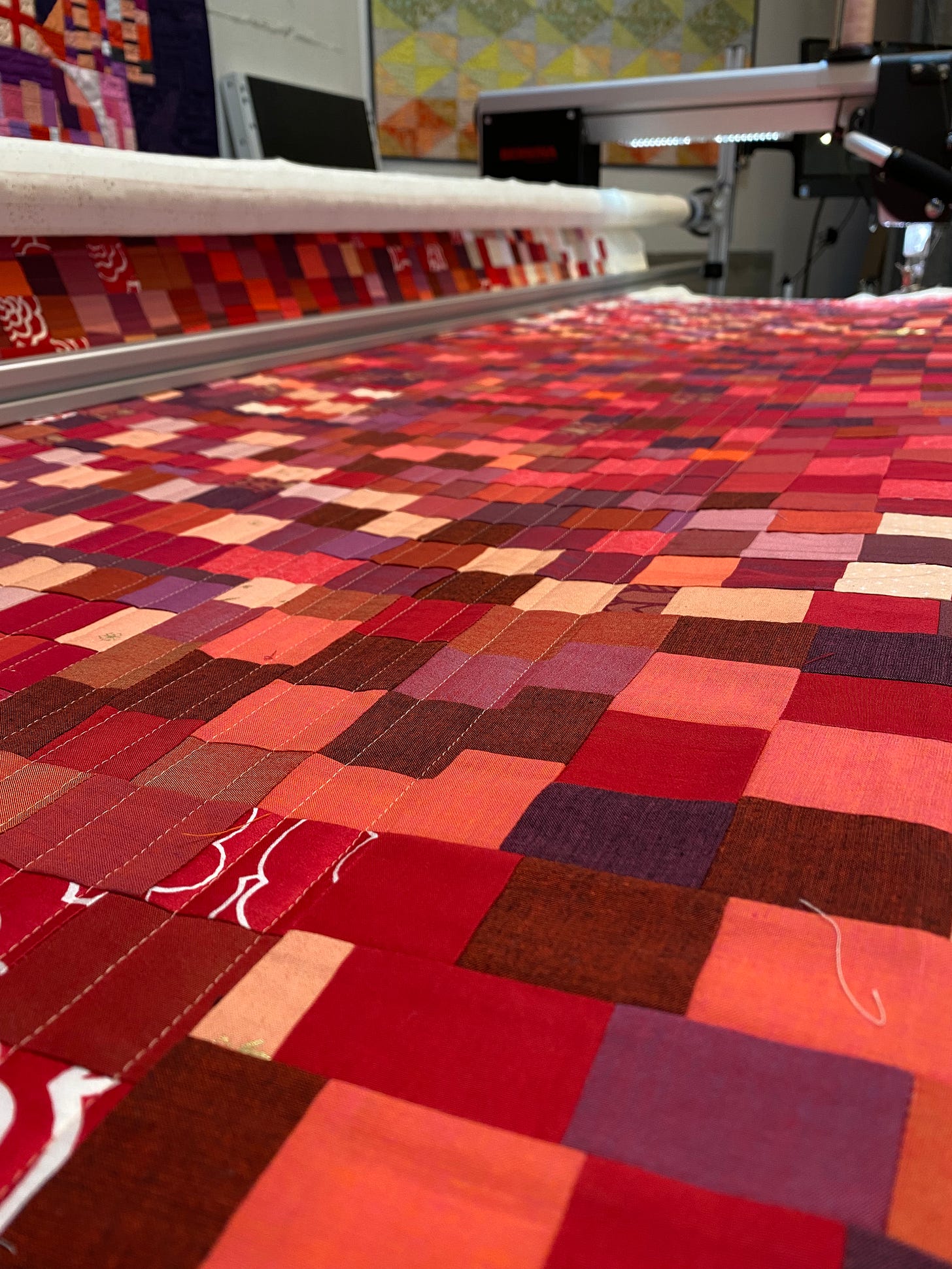
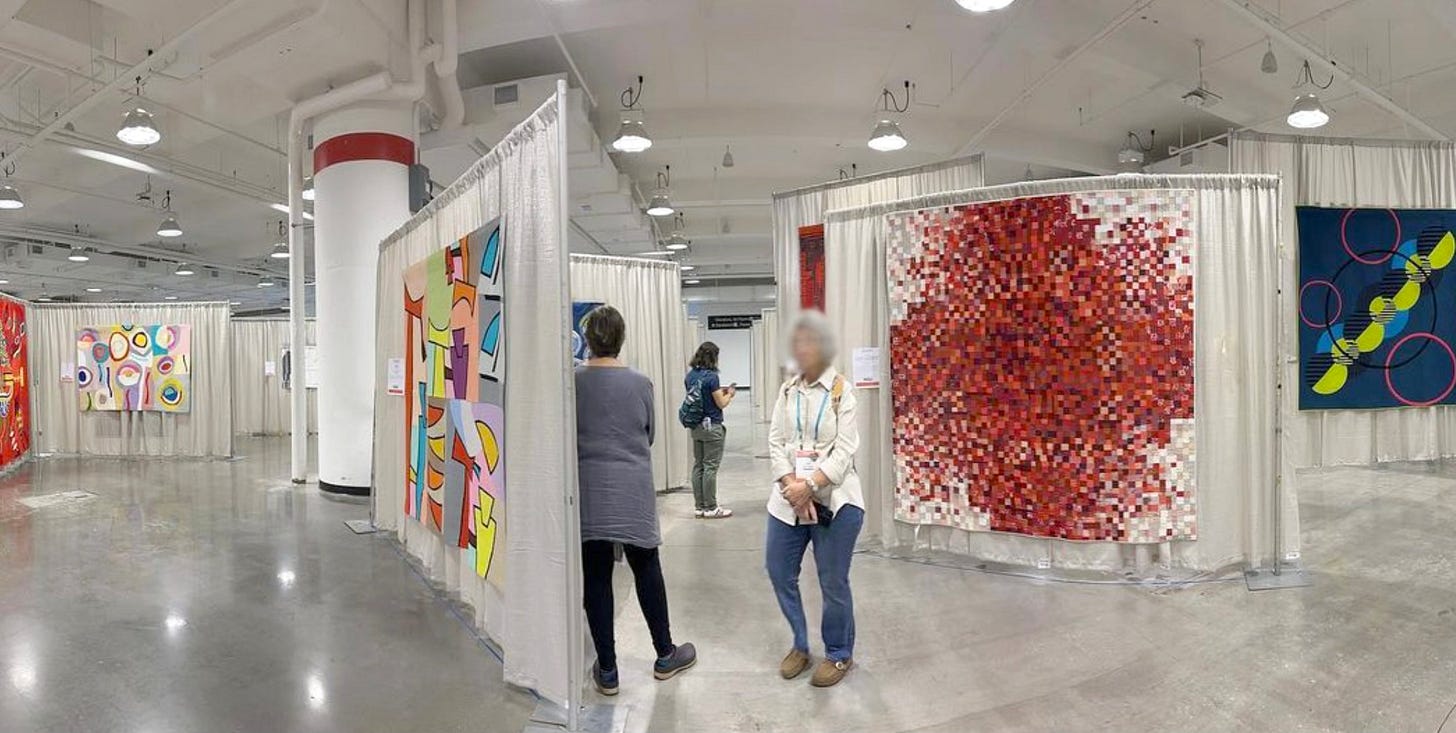
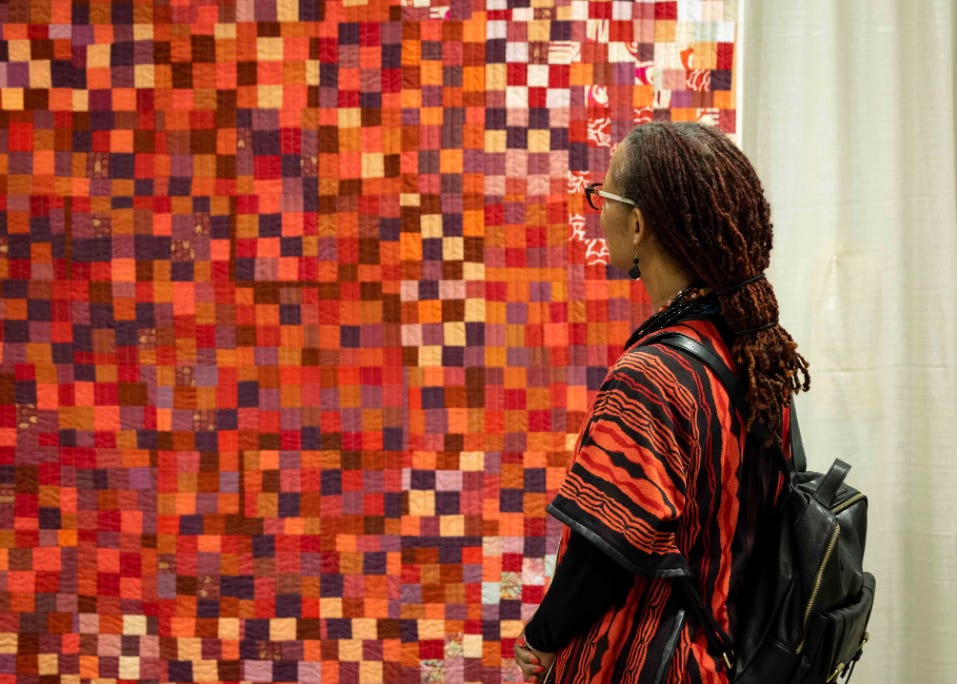
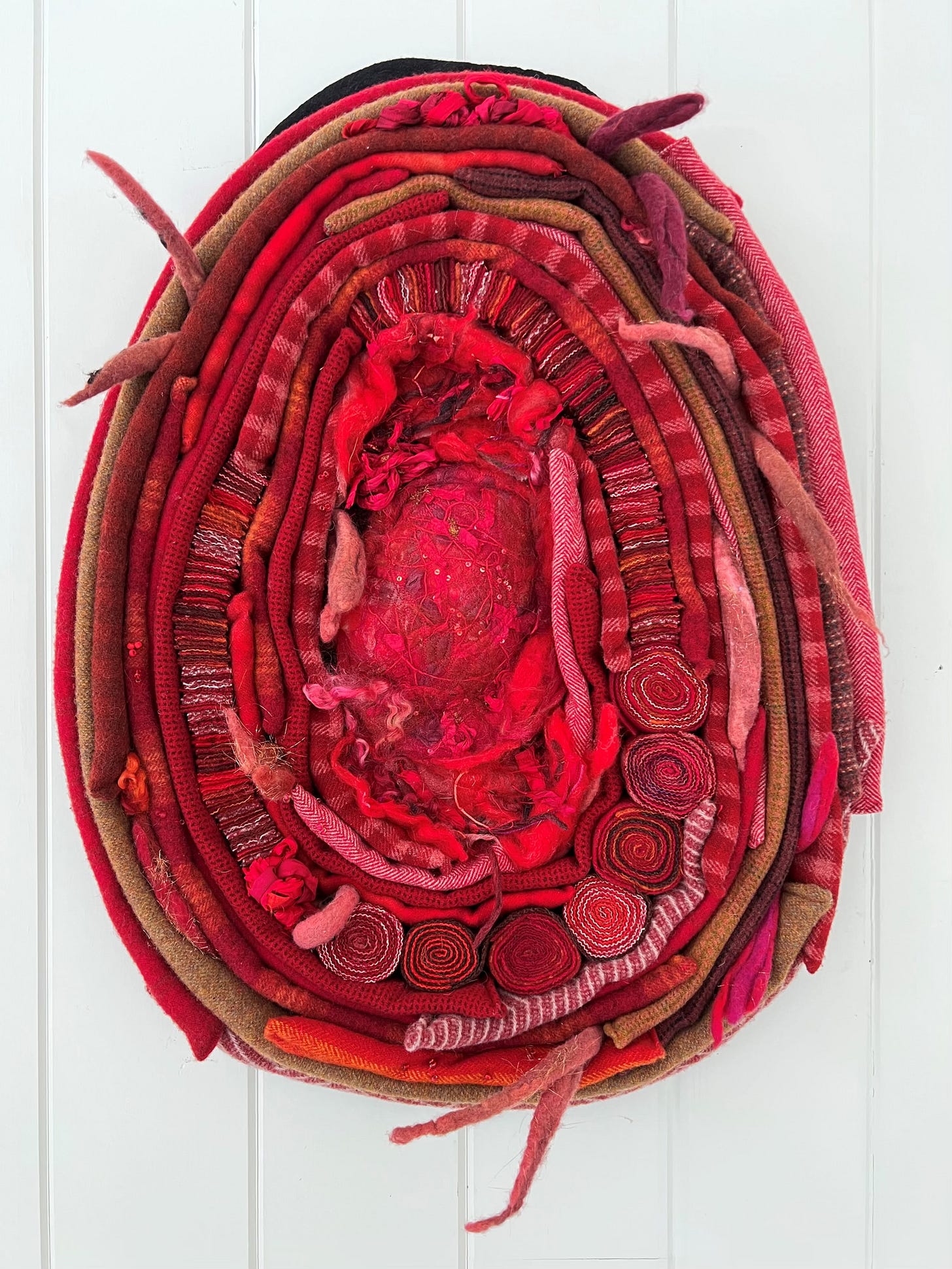
I’m so proud of you for sticking up for our rights and making this issue more public than AQS ever thought it would be. I was scheduled to write an article for American Quilter the week this happened. I canceled the article and my membership to AQS immediately with a letter of my disapproval of their decision. I did this back in the 1990’s after they banned Jonathan’s quilt and they reversed their decision. When they held their position this time I said my farewell to an organization I had belonged to since its inception in 1985. We must stand together to be heard. Thank you!!!
I am so proud of quilt artists that make a statement. Art is to be something that makes one question, feel and enlighten. I cancelled my AQS as soon as I heard of your quilt being censured.